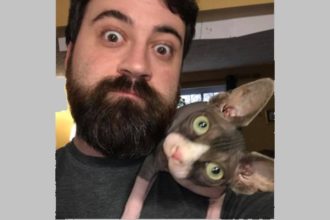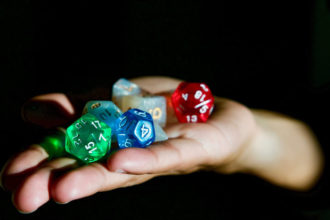Interview with Fan-Favorite Artist, Todd Lockwood

Todd Lockwood is one of the most recognized and prolific fantasy artists in the gaming industry. His work contributed to the reinvention of the 3rd Edition D&D Monster Manual, as well as the iconic characters of the 3rd Edition Player’s Handbook. He has painted the covers of R.A. Salvatore’s Drizzt Du’orden novels since 2001, and his art has graced Magic: The Gathering cards since 1998.
Gaming
Before we talk about your art, let’s talk a little about your history with gaming. Who first got you into gaming? Was there a specific game that got you hooked?
A friend of a friend, Scott, who played D&D in the service in Germany, in 1977. We played the rules that came in pamphlets in a white box. The first character I rolled up, using three dice only, with one roll per stat, generated an 18 strength, an 18 constitution, and a charisma of 8. When they asked me what his name was, I looked around the room a bit confused. What? I need a name straight away? I glanced at the books on the wall, hoping to find inspiration. There was an English text there. “Glish!” I said. There was laughter all around. Perfect. As it turned out, he was the only survivor of internal fighting, and went on to many great adventures, beginning with everything good that every other player had on them. I was hooked.
Do you have a favorite genre to run? How about to play?
My own game world was a Ringworld, ala Larry Niven’s novel by that title, because I wanted the option to toss in science fiction from time to time. But the rules favored fantasy, and so it was largely a fantasy setting. I suppose I deferred to the rules, since science fiction was my first choice in reading material then. Eventually, our group played in many settings. I think my favorites were D&D, Shadowrun, and Earthdawn.
Do you have a favorite archetype or class to play? Does it change depending on the genre?
I don’t know about favorite archetypes. I liked fighters and magic users. Didn’t care for thieves or clerics of any stripe, though I tried them all. My favorite characters were an Illusionist (15) / Magic-User (24) dual-classed player who acquired psionics in D&D, and an Obsidiman Fighter/Mage in Earthdawn. Many years of campaigning!
Art
What is your favorite medium to work in/with? Does it change depending on the type of project (Magic Cards vs Covers vs RPG supplements)?
My favorite traditional media are graphite and oils. But I really do love digital paint, sadly. Sadly because there is no original when I’m finished—just a file. I do miss paintings. But I don’t miss painting. When I use traditional media any more it is for very special projects that matter to me for personal reasons.
Was becoming a professional artist always your goal?
I always knew I would be an artist, I suppose, though I suppose it was more my parents’ idea than my own. Both were talented artists in their own right, but self-taught and working in other fields. My father was a civil engineer and my mother, unsurprisingly for the era, was a housewife. Either could have had a career as an artist. I was their surrogate. It took me a long time to learn that. Ultimately, I think that I am where I wanted to be, even if I had to go the long way around to get here.
Can you tell us a little about your heroes in the industry?
That’s a long list, and I’m bound to forget people who meant a lot to me. NC Wyeth and Maxfield Parrish were among the first, plus Rembrandt and Walt Disney. Frank Frazetta and Michael Whelan were like the left brain/right brain fathers of my artistic inspiration. One is all passion, the other so smart and thoughtful. Those are either side of a venn diagram I tried to be in the center of, I guess you could say. There were many others in advertising and in this industry: Jeff Easley, Keith Parkinson, Jeff Jones, Frank C. McCarthy… Too many to name.
What previous or current job or degree has helped you the most working in the industry?
I believe that the best art schools I ever attended, in order, were TSR and Wizards of the Coast, convention art shows, and the Colorado Institute of Art. I attended them in reverse of that order, but all were influential, and to be fair I couldn’t have done it in any other order than the reverse. In retrospect, it was something of a perfect progression.
Are there classes, schools, degrees, or sage words of advice you think would help artists looking to break into the industry?

I’m going to quote myself, from the FAQ on my website:
Art is a passion, or it will kill you. Your love of art will have to sustain you during the lean times. That said, once you have paid your dues and built a following, it can be very rewarding personally, and possibly financially.
Does the phrase “starving artist” ring a bell?
A career in art is, I suspect, much like a career in any of the other arts. A certain tiny number will achieve fame and fortune, another few will achieve fame, but little fortune, others will find good jobs, if only somewhat satisfying, and very many will toil in obscurity until they give up or find something better.
I don’t mean that to be discouraging, but if you’re lazy, don’t be an artist. If you want to spend your weekends lounging around the pool, doing nothing, don’t be an artist. if you expect to graduate from college, land a terrific job and start kicking asses, don’t be an artist.
However, if you love to create things, if your primary means of entertainment for yourself was drawing pictures and/or story telling then you may have what it takes. In fact, if you have those ambitions and don’t pursue art, you may spend the rest of your life wondering whether you had the chops, if you had missed your calling.
Talent is only part of the equation. There are many artists more talented than I who have failed and disappeared. I work my ass off. I go to conventions, I network with other artists and enjoy the company of people around the industry. I spend a lot of time in research (which I find enjoyable), put a lot of thought into every painting, and am always seeking to improve my craft. It’s a matter of desire. After 15 years in advertising, I HAD TO DO THIS. I started attending conventions in hopes of landing more enjoyable work, or I was going to hang up my brushes and get a real estate license. Art was and is my lifeblood. Creating is what I do. If you are the same way, then challenge yourself and study art. If you are just a guy who draws occasionally and thinks that art might be a good way to make some money, you’re on the wrong track.
Joseph Campbell once said, “Follow your bliss, and doors will open where you did not know there were doors”. It’s true, it worked for me. You need to ask yourself what you enjoy most. What gives you the greatest pleasure? What do you do when you have leisure time and want to entertain yourself? That’s where your greatest level of satisfaction in a career will be found. You will excel when you love your work. If art fires your imagination and inspires you, then follow that bliss.
What art projects have you worked on recently that have excited you? What can you tell us about what you’re working on now?
My favorite projects currently are those that allow me to pair my two muses: painting and writing. I’ve sold a number of short stories and have a contract for a novel with DAW Books that is in the works. Anything that turns my storytelling muse loose is a favorite.
Prose
That brings me to my next question. In addition to being one of the most respected fantasy artists in the industry, you are also a writer. What made you decide to make the leap from art to prose?
I have never not been a story teller. I learned to draw by making my own comic books, in which, in my mind, I was telling movies or TV shows. Story-telling has always been at the center of my passion. In 2003, I decided to put energy into an art book with a simple story line threading the images together.. But when I started, a long dormant passion was awakened. Before I knew it I had characters, a world, and a story to tell. I spent the next decade work-shopping, reading the books on writing, attending seminars, and otherwise honing my craft. Little by little I had a product that a publisher wanted. I couldn’t be happier to be in Betsy Wollheim’s capable hands. I don’t have a release date yet, but I’m working steadily.
Life and the Future
Besides publishing your novel, what are your plans for 2015 and beyond?
I have to admit that I’m a bit like a guy riding a mechanical bull. I don’t know what’s next; I just keep hanging on and moving with it. If anything is true about my career it’s that I’ve refused to be thrown.
Outside of your art and writing, what other hobbies and interests do you have? Do you even have time for them?
I love landscaping and gardening. I like home-improvement (I finished the lower lever of our first house single-handedly, with permits and everything, from plumbing to electrical, framing, drywall, finish carpentry—all of it—including a three-piece bathroom, laundry, two bedrooms, a family room with built-ins, and a studio). I love science and politics and philosophy (wish I’d had an opportunity to study it properly), history and mythology.
With so many creative projects on your plate, how do you balance your time between work, family, friends, conventions, etc?
Poorly.
Last question; both technology and the industry change every year. Is the jump from fan to professional different today than it was for you? If so, how?
I couldn’t possibly answer that question meaningfully. I struggle to keep up with every new thing!
Thanks so much for taking the time to talk with us, Todd. We wish you much success for your upcoming novel and are looking forward to seeing your future projects.
——-
To see more of Todd Lockwood’s art and read his fascinating mini-bio, link over to www.toddlockwood.com.
To get a taste of his prose, link over to our review of the “Tales of the Emerald Serpent” anthology and check out Todd’s short story, “Between”.




